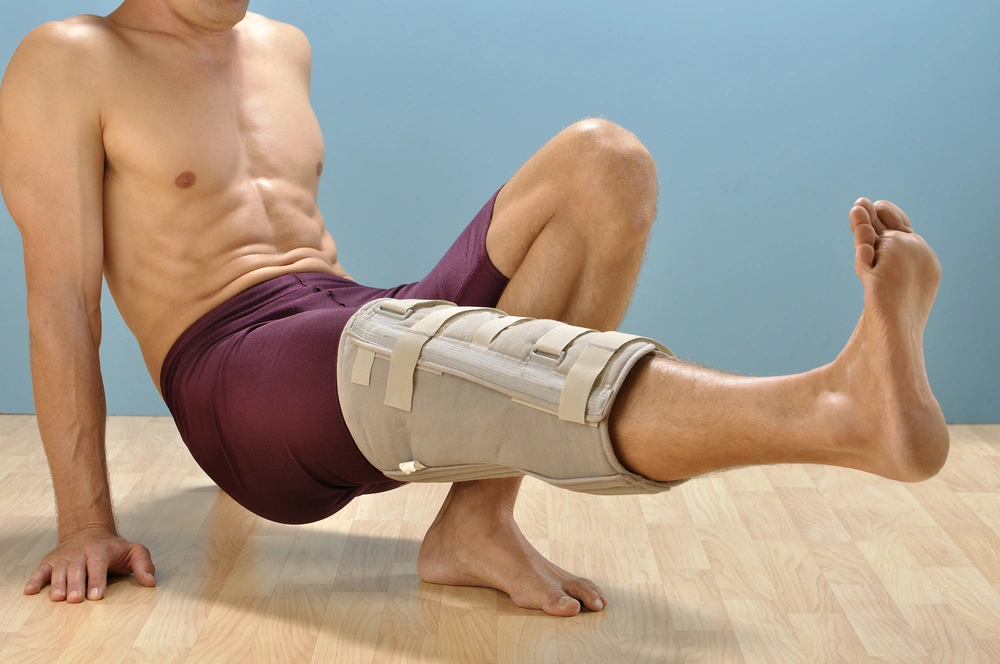The ACL Rehabilitation Protocol has the aim to reduce swelling and inflammation, regaining Range of Motion (ROM) strength and neuromuscular control and gait training.
The later stage of rehabilitation includes full strength and power restoration, sport specific exercises and reconditioning.
The patient must be taught how to manage the pain following each workouts/session.
Ice may be need to be applied if pain, inflammation or swelling appears.
Immediately after surgery, weight bearing status is largely determined by concomitant injuries (e.g. meniscal repair). Isolated ACL reconstructions are typically treated weight bearing as tolerated, using brace and/or crutches until adequate quadriceps muscle strength is restored. We can expect to remove both crutches and move to full weight bearing in the first 2 weeks.
The results of ACL reconstruction are good, but current techniques do pose their own challenges and potential issues. These include decreased hamstrings strength, anterior knee pain and loss of proprioception. There is also significant evidence to suggest that ACL reconstruction does not prevent future osteoarthritis.
Return to run (RTR):
RTR decision-making should be individualized for each patient. No universal timeline to RTR exists.
For many patients, it might be reasonable to expect readiness to RTR around the 8th–16th postoperative weeks, provided there is adequate loading: pain <2 at visual analogue scale (VAS) , 95% knee flexion ROM, full knee extension ROM and no effusion.
The clinician may choose to use a battery of tests for individualized clinical decision-making regarding RTR including; strength tests, qualitative performance-based assessments, with focus on dynamic knee control, and quantitative performance-based assessments such as hop tests.
Post-operative ACL Rehabilitation conclusion:
Multiple types of bracing were evaluated, including knee immobilization, rehabilitation bracing, and functional bracing. Overall, no brace or length of brace wear demonstrated an advantage over another type of brace, another duration of bracing, or no bracing at all. Bracing does not provide any benefit and is not necessary.
Accelerated Rehabilitation has shown no deleterious effects, and it is likely safe for patients to begin immediate postoperative weight-bearing, move the knee from 0 to 90 of flexion, and perform closed-chain strengthening exercises.
Eccentric quadriceps muscle strengthening and isokinetic hamstring muscle strengthening were safely incorporated three weeks after surgery; they may be safe sooner, but further research is needed.
Home-based rehabilitation can be effective. Neuromuscular exercises are not likely to be harmful to patients; however, their impact was small, making them unlikely to yield large improvements in outcomes or help patients return to sports faster. Neuromuscular exercises should not be performed to the exclusion of strengthening and range-of motion exercises.
Neither supplemental vitamin C nor vitamin E appears to be beneficial. Postoperative hyaluronic acid injections may improve some measurable parameters, but their cost must be kept in mind.
Single-leg cycling to maintain cardiac fitness may be beneficial. Continuous passive motion (CPM) is still not recommended. The studies presented in this paper focused on improving rehabilitation following ACL reconstruction, with a goal of safely allowing expeditious return of mobility, strength, and ultimately sport participation.
However, few studies actually measured the ability to return to sports and its timing following the interventions. The availability of such data could strengthen the conclusions of studies and should be considered in future research. Despite the large number of randomized trials, further investigations of the timing of rehabilitation and supplemental rehabilitation exercises are needed to continue to improve the care and function of patients following ACL reconstruction
To learn more about ACL Injury, please visit our dedicated page here: ACL Injury Treatment
